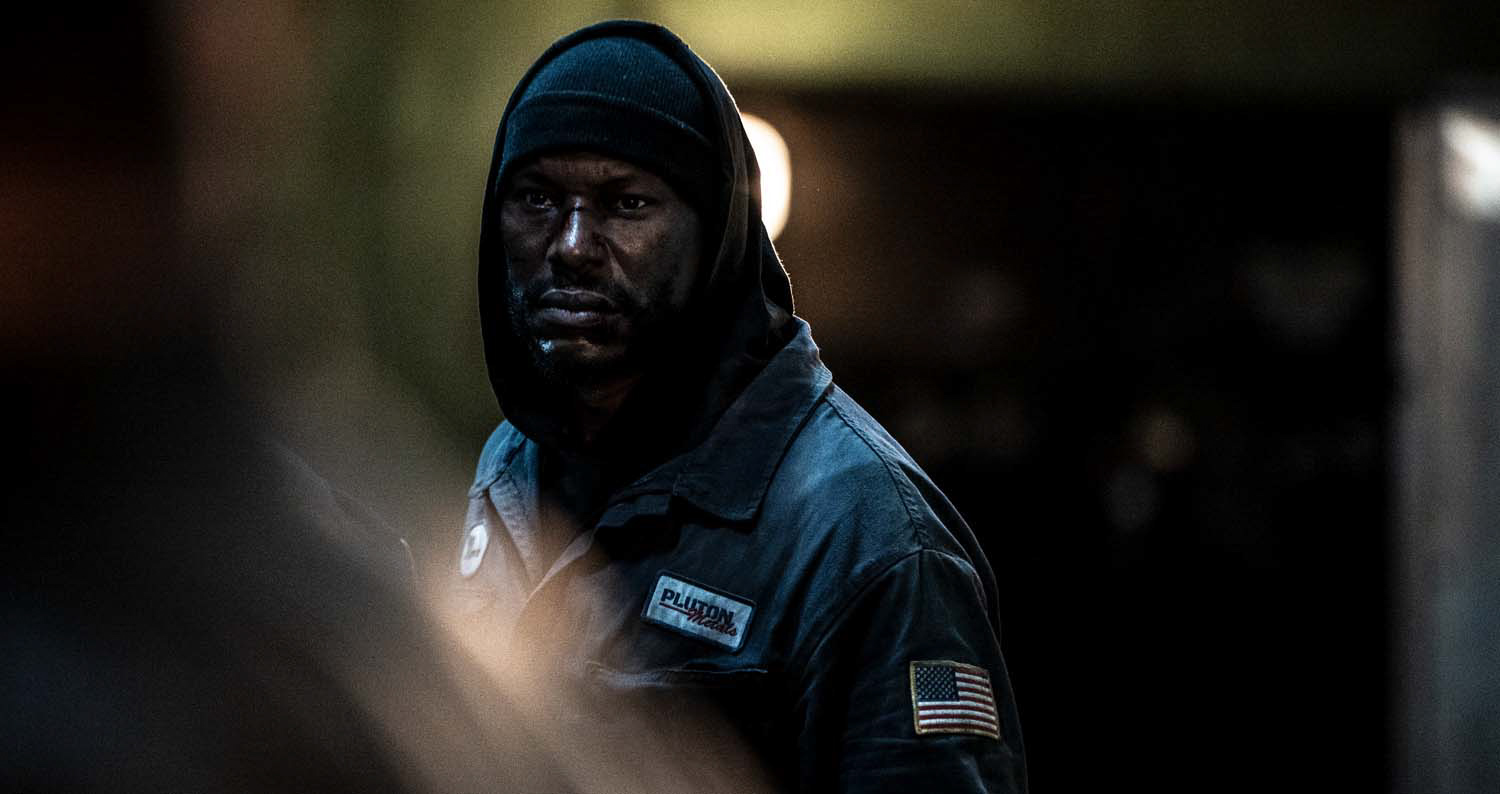Entertainment
Rep. Joaquin Castro says ‘Blood In, Blood Out’ should be added to the National Film Registry

As part of his work to champion Latino inclusion in Hollywood, U.S. Rep. Joaquin Castro (D-Texas) has recommended that the crime dramas “Blood In Blood Out” and “American Me” be entered into the Library of Congress’ National Film Registry for 2024.
“Both movies were able to show the humanity in the Latino community, even within very flawed characters,” he said, while acknowledging that the films depict characters as gang members — a long-held stereotype in media. “It was an exploration of a certain life. I’ve always thought, at least one of those deserves to go in there.”
This is the third year the congressman has sent a letter to the National Film Preservation Board recommending a list of “Latino-driven” stories for the registry. It’s part of his ongoing campaign to memorialize the ethnic group’s contributions in media and push for continued representation in American culture.
He believes the entertainment industry is one of the largest “narrative-creating” institutions and its decisions to portray negative tropes are harmful.
Every year, the board adds 25 titles to the registry. So far, three of Castro’s more than 50 nominations have been selected, including the biopic “Selena” starring Jennifer Lopez, based on the life of the iconic Tejana singer Selena Quintanilla. For the congressman, it’s still insufficient considering the artistic contributions to movies by Latinos.
The registry’s goal, according to its website, is to ensure that selected films are conserved to increase public awareness and accessibility for educational purposes. Anyone can submit a nomination.
However, according to Brenda Victoria Castillo, president of the National Hispanic Media Coalition and a recently appointed member of the National Film Preservation Board, less than 5% of the 875 films preserved are Latino-themed.
“The Latine community, along with its films and unique stories, has a significant impact on the cultural history of the U.S., making it essential that we preserve them for future generations,” Castillo said.
The ethnic group is one of the largest consumers of media, according to a McKinsey & Co. report earlier this year, as the firm purports the highest per capita theater attendance rate at an average of 3.3 times a year. The report found that films with a Latino producer, director or lead earned 58% more between 2013 to 2022.
Yet, they are historically underrepresented both behind and in front of the camera, according to two reports from USC Annenberg School of Communication and Journalism. The first found that, between 2007 and 2019, 3.5% of leads in films were Latino. The second found that, between 2007 to 2022, 3.7% of directors were of Latin descent.
Felix Sanchez, a co-founder of the National Hispanic Foundation for the Arts, said that adding films from Castro’s list to the registry will help families find titles told with unique cultural perspectives.
“It’s very hard to have big numbers when you have small content,” Sanchez said. “We can only nominate what we have and the numbers are small in terms of what’s possible for the registry.”
He added that the list of nominees can also be used as a tool to showcase the continued success of these narratives to Hollywood executives who might be cautious about investing in projects.
Castro has called out Hollywood executives for their “pervasive lack” of positive representation in a 2020 Variety article. He lauded “Blue Beetle” for being the first live-action Latin superhero depicted in a feature film and said he looks forward to the growing number of nomination options in the coming years from the public once those movies reach the required 10-year eligibility mark.
“Those contributions, I expect, will receive even greater recognition,” he said.
The official list of films added to the registry will be announced in December. Public submissions for this year are closed, but nominations for the registry’s 2025 list are now open until Aug. 15.
Castro’s 2024 list of nominations:
1. “Blood in Blood Out” (1993)
2. “Frida” (2002)
3. “Like Water for Chocolate” (1992)
4. “Mi Familia” (1995)
5. “Y Tu Mamá También” (2001)
6. “La Misma Luna” (2007)
7. “American Me” (1992)
8. “Tortilla Soup” (2001)
9. “The Milagro Beanfield War” (1988)
10. “Cesar Chavez” (2014)
11. “Pan’s Labyrinth” (2006)
12. “Motorcycle Diaries” (2004)
13. “Mi Vida Loca” (1994)
14. “Instructions Not Included” (2013)
15. “Chicano I & II: The Mexican American Heritage Series” (1971)
16. “La Mission” (2010)
17. “Babel” (2006)
18. “125 Franco’s Blvd” (2010)
19. “Don’t Let Me Drown” (2009)
20. “Bless Me, Ultima” (2012)
21. “Walkout” (2006)
22. “Gotta Kick It Up!” (2002)
23. “Mosquita y Mari” (2012)
24. “Gun Hill Road” (2011)
25. “American Experience: Roberto Clemente” (2008)

Movie Reviews
Saripodhaa Sanivaaram Movie Review Rating


Saripodhaa Sanivaaram Movie Review
Telugu360 Rating: 3/5
Story:
As a teenager, Surya (Nani) was known for his violent reactions to injustice. Before she passed away, he promised his dying mother that he would control his anger, allowing himself to explode only one day a week—on Saturdays. Dayanand (SJ Surya) is a notorious CI in the city, and Koormanand (Murali Sharma) is his brother. Surya, disturbed by Dayanand’s atrocities, decides to take him on. Meanwhile, Surya’s childhood love Charulatha ( Priyanka Mohan) and Dayanand’s brother enter the story. The ensuing tangle between Surya, Dayanand, and Koormanand forms an intriguing triangular race.
Analysis:
Vivek Athreya, known for directing class films like Mental Madhilo, Brochevarevarura, and Ante Sundaraniki, has made his mass film debut with Saripodhaa Sanivaaram. Nani, typically known for his family-oriented roles, stars as the lead. The collaboration of these two filmmakers, both rooted in family-oriented cinema, has created unique expectations for this out-and-out mass entertainer. Nani’s introductory scenes are well-executed, though the pacing slows a bit before the antagonist, Dayanand, enters to pick up the momentum. Up until the interval, the film remains a decent watch. The post-interval block, lasting about 45 minutes, is racy and smart. However, the pre-climax episodes drag a bit, though the film wraps up on a satisfactory note with a strong climax.
Notably, the makers avoided including unnecessary songs, item numbers, or romantic tracks. There is only one montage song . The film is a 160-minute action drama without any duets.
Vivek Athreya cleverly used Murali Sharma’s habit of misjudgment to both entertain the audience and drive the story forward. The chapter titles representing key script elements— “Introduction,” “Twist,” “Conflict,” “Interval,” “Post Interval,” and “Ending” – add an interesting layer to the narrative. His wit cannot go unnoticed in certain scenes.
The casting is one of the film’s highlights, with everyone excelling in their roles. Nani, SJ Surya, Murali Sharma, Saikumar, and Priyanka Mohan all appear comfortable and seem to have thoroughly enjoyed performing in the key scenes. S.J. Surya might have received a bit more screen time.
Jakes Bejoy background score is trendy. Murali’s photography is Good.
On the downside, the film has a few dull moments in the first half, some predictable elements, and could benefit from trimming about 15 minutes, especially around the pre-climax.
Positives:
- Unique storyline
- Nani’s mass avatar and strong performance
- SJ Surya’s outstanding performance
- Vivek’s direction and clever screenplay
- Impressive background score
- Well-developed key characters
Negatives:
- Lengthy runtime
- First half has predictable scenes
- Flat narration in the first half and drag in pre-climax
- Sokulapalem sequences
Verdict:
‘Saripodaa Sanivaram’ is an action film but not your typical one..It has an average first half but a gripping second half with a unique storyline. Nani and SJ Surya shine with standout performances in this face-off themed film. Vivek Athreya delivers a smart screenplay with adequate wit and action,though the film suffers from a lengthy runtime that occasionally results in flat storytelling. Overall, it’s a watchable action drama. Give it a try !
Telugu360 Rating: 3/5
Director:Vivek Athreya
Cinematography: Murali G.
Music: Jakes Bejoy
Producer:D. V. V. Danayya
Production:DVV Entertainment
Summary
Reviewer
Krishna
Review Date
Reviewed Item
Saripodhaa Sanivaaram Review
Author Rating
Movie Reviews
1992 movie review & film summary (2024) | Roger Ebert

Count “1992” as one of those films with its heart in the right place but its execution in the wrong space. Set on April 29, 1992, the day of the Rodney King verdict, this is a surprisingly uncomplicated film, one that attempts to balance its heist-thriller elements with its combustible racial milieu. It features Tyrese Gibson as a single father named Mercer, working to protect his teenage son Antoine (Christopher Ammanuel) from the surrounding violence only to upset an ensuing robbery led by Lowell (the late Ray Liotta) and his crew. There are shootouts, a car chase, some heroics and some hard life lessons—but this film isn’t breaking new ground on either the action or socio-political front.
Director Ariel Vromen’s “1992” often plays like a significantly lesser mishmash of Kathryn Bigelow’s “Detroit” and John Carpenter’s “Assault on Precinct 13.” It poses a one-night structure that puts to test the resolve of its Black protagonist to simply survive the night whether through brunt force or through pained civility. And while certain thrills can be had from its nuts and bolts construction, you’re left wanting this film to lessen its well-worn genre elements in deference to the difficult father-son dynamics it initially sells.
Those dynamics, in an on-the-nose script written by Vromen and Sascha Penn, come in two forms. The first arises between Mercer and Antoine. The former was recently released from prison six months ago, and now he’s working on not going back by staying away from the gang he once ran with and by plying his trade as a maintenance worker in a plant. Mercer, of course, doesn’t want Antoine to follow in his footsteps. So he has the teen, despite Antoine’s charge that he’s being locked in a proverbial cage by his dad, to return directly home from school. The film’s other strained father-son relationship is Riggin Bigby (Scott Eastwood) and his father Lowell. It’s Riggin who thinks up a get-rich-quick scheme, proposing that Lowell’s gang rob Mercer’s plant where there happens to be $10 million worth of platinum—with the uprising associated with the Rodney King verdict providing the perfect cover for their plan.
Of the two threads, it’s clear that Mercer and Antoine have a far more potent relationship. Through their eyes we are transported back to the hood films of the 1990s, where the potential for danger seems to rise higher around every corner. It’s here Mercer is still a local legend for his violent ways. In the film’s first half, Gibson remains stoic, as though he is afraid that any show of emotion will lead to trouble. The same could be said of his hunched posture, the way his body is swallowed up by the oversized jumpsuit he wears to work. This is a man attempting to change himself from the inside out. When Mercer’s acquiescence is thrown against Antoine’s fervent desire for revenge following the verdict, an enthralling explosiveness develops between the two. Unfortunately that energy is often undone by the film’s frank dialogue and blunt scenarios, such as a police barricaded roadblock that nearly goes wrong.
That father-son relationship only leaves the other more wanting. We know that Riggin is tired of working for his dad and his band of petty criminals. He also wants to take his younger, sensitive brother away from Lowell. Beyond that the writing just sorta stops. There are very few scenes between Liotta and Eastwood, which admittedly, might have been out of Vromen’s hands. We’re not sure why Riggin hates Lowell and vise-versa. Nor do we get a sense of Lowell. Liotta is delivering his lines with confidence, but they don’t string together into a complete character. He is merely violent and heartless, and not much else.
Fascinatingly, these two families do not immediately meet. In fact, Lowell and his crew are halfway done with their robbery, over halfway through the film, before Antoine and Mercer stumble onto their criminality. The film then becomes a fight for survival as Mercer and Antoine attempt to avoid Lowell’s wrath. Though the majority of the action happens in these scenes, the film, mysteriously, appears to slow down. There is no suspense to Mercer brawling with Lowell’s men. Maybe that’s because it’s all been thrown together at the last minute, casting away the pleasures of seeing rivalries and vendettas that have naturally been developed over the course of the picture? Or maybe it’s because the shooting of these sequences is fairly rudimentary?
In any case, “1992” doesn’t wear its genre elements well. It can also struggle in the edit too, such as the clumsy integration of archival footage from the Los Angeles uprising. Vromen can’t decide whether to show us those images via the television, whose broadcasts of the news often occupy the back of the composition or to show it as a documentary. The score also feels mismatched, opting for syncopated jazz music in a film that plays as far too sweaty and far too grimy for such precise percussion.
And yet, it’s difficult to wholly disavow this film. There is an albeit obvious tension in two Black men avoiding these white criminals while in the film’s outer world white folks are steering clear of Black protestors. There is also a palpable anger felt by Mercer and Antoine that the film understands. And Liotta, in his final completed film, is a plus presence. You just wish all of those elements came together in a movie that had the ability to lean on its human components and find drama in their relationships rather than pushing them aside for lackluster set pieces in a conventional social picture.
Entertainment
ShyBelligerent, reformed pimp turned rapper, shines a light on vulnerability in L.A. hip-hop

ShyBelligerent is hurting.
You can see it in his videos, where he paces helplessly through cemeteries and city streets and unfurnished bedrooms. You can hear and feel it in his voice. The 30-year-old rapper born Michael William, who is rail-thin with sharp, angular features and a pencil mustache, is also fearless on the page. He writes about all that’s been done to him, and all that he’s had to do.
“I can’t forget about the past,” he wails on his latest album, “It’s a Ugly Come Up.” “Where the Hennessey at? I’m finna down that. My whole life, I’ve been down bad.” The beats, mostly piano-based, are exquisitely complementary. Shy himself is movingly human — full of vim but also lonesome and afraid.
“I got to plot it out,” Shy says of the new album. “I actually got to make it a great project.” Much of his previous work was rushed and improvised. This time around, though, Shy took his sweet time. Lyrically and thematically, “It’s a Ugly Come Up” is focused without infringing too much on the spontaneity that has become Shy’s trademark.
For Shy, lyrics are of secondary importance. His power is in his voice — a twitchy, erratic, untethered yelp — that reveals him not as a victim, but as a vessel of chronic pain. The Compton native says he is tormented by what he’s experienced or, more to the point, what he can’t un-experience. How appropriate that Shy tweets under the handle “@sbbenthroughit.”
His song “Cry Me a River,” is a desperate airing of grievances. Thus far, “River” is the most viral song Shy has ever made (156,000 YouTube views and counting).
“In the L.A. music scene, my problem as a producer is that everybody sounds like everybody else,” says TooRawEntertainment, Shy’s producer who sends him beats from his studio in Arizona. “[Shy] definitely stands out. His delivery is crazy and his energy is even crazier. And he tells the truth, for real, in his raps.”
The “Cry Me a River” video captures the L.A. rapper flopping around in a raggedy tent adjoining a rail yard. Shy is not unhoused — he is in fact a very vocal tenant of the Housing Authority of the City of Los Angeles, better known as HACLA. Though he has a place to stay, at times he seems lost in his chaotic interior world. In conversation, the rapper lives up to the implied duality in his name — alternating between quiet and rambunctious. But if you only know him through his music, nothing can prepare you for just how demure and put-together he is in real life.
“I think it’s one of the most remarkable things about him,” says DeJon Paul, a rap critic and blogger from Inglewood who is also a regular on the popular hip-hop podcast “No Jumper.” His local gravitas provides a refreshing contrast to “No Jumper” host Adam22. Each year Paul rolls out the local equivalent of XXL magazine’s Freshman Class list. Shy was one of the chosen few in 2023.

In conversation, ShyBelligerent lives up to the implied duality in his name — alternating between quiet and rambunctious.
(David McGriff)
“He has this bombastic personality on wax and in his videos,” Paul said. “ But when you hang out with him or when you interview him, when you run into him in public, he’s quiet, stoic, he’s to himself, he’s reserved.” The explanation for that lies in Shy’s upbringing.
“It wasn’t your typical mother-father scenario,” Shy says. “My mother was supposed to fight for me, but she just wasn’t able to.” His mother walked out when he was an infant. His unstable father was not any better prepared for parenthood. As a child he was “signed over” to his stern, churchgoing grandmother and jazz-enthusing grandfather. Shy remained in their care until he was 15.
Some good came of this familial arrangement. His grandfather instilled in him a musical curiosity that persists to the present day (“That’s why my style is so unique”). But Shy was a cowed and glum child. His world, small to begin with, shrank by two when his parents left his life. He couldn’t make sense of it. The more he fumbled for answers, the more overwhelmed he became by entropy and uncertainty.
“Later down the line,” Shy says now, “I was able to speak up and ask questions and figure things out.” But in grieving his lost youth, he became quarrelsome and sometimes belligerent. Shy’s trajectory is all too familiar: frightened, neglected boys often become angry men.
For a time he sought release and restoration in the classroom (his favorite course was Honors English). The gridiron was another precious sanctuary; Shy played defensive end on the Compton High football team. Even then, however, he had designs on a rap career; it was around 2009 when he got serious about his craft. L.A. is a networker’s paradise and Shy likes to network, but he didn’t always. His teenage apprenticeship was completely informal and self-supervised.

“This was when YG was in his prime,” Shy says. At the time, YG was an up-and-coming wiry truth-teller, a fellow Compton rapper who turned into a superstar and provided Shy with a blueprint of how to succeed. “I was trying to make a name for myself then, but with the little resources I had, the little knowledge I had at that moment, it was rocky.”
William had at his disposal only the cheapest of equipment — RadioShack microphones and “busted-up laptops.” Eventually he built a functioning studio out of primitive equipment.
If Shy’s creative life suffered, it was because he had competing responsibilities. He fathered a child at 15. This enraged his fundamentalist grandparents, who sent him scrambling for steady work, much like Ice Cube on “A Bird in the Hand.” He worked in dollar stores, warehouses — any place that would pay him a legal wage. Shy’s employment history is largely aboveboard, but he’s done things for money that by his own admission are inexcusably vile.
As Shy’s rapping evolved, so too did his journalistic sense. He began to experiment with the vlogger model of YouTube street reporting. The following he gained from this activity wasn’t huge relative to the biggest vloggers, but it also wasn’t negligible. Shy says he has a knack for timing, for providentially capturing extraordinary scenes as they happen.
On tracks such as “Son of a Bitch,” William recounts a period in his life when he was “pimping hoes.” This isn’t a euphemism nor is it a case of hip-hop fabulism. He has direct experience trafficking women.
“It was for a short amount of time,” he says, while conceding that he was active long enough to inflict lasting damage on the women funneled into his “stable.”
“Having daughters would make you rethink the whole situation,” he says. “I’ve seen a bigger picture now.” These may sound like limp platitudes, but on “Son of a Bitch,” Shy sounds like the most spiritually tortured ex-trafficker in hip-hop history. (Suga Free with a conscience? All jokes aside, their rapping styles are very similar.)
Watts had always functioned as a second home for Shy, and at some point he moved there permanently. In retrospect, Watts was the best place he could’ve gone. Shy’s identity is bound up, almost inextricably, with this close-knit community of 35,000. Would there be a ShyBelligerent if he still were mooning around Compton?

Watts functioned as a second home for ShyBelligerent and at some point he moved there permanently. His identity is bound up, almost inextricably, with the community.
(David McGriff)
Shy’s adopted home is fertile ground for rap talent. He currently lives in the low-slung, lemon-hued Nickerson Gardens apartment complex and identifies intensely with the place. In his X bio, Shy introduces himself as an unsigned artist from Nickerson Gardens. His free agency is a geographic catastrophe, and also an A&R failure, says Paul.
“I’m surprised TDE hasn’t snatched him up,” Paul says, referring to Top Dawg Entertainment, the prestigious label whose roster — Kendrick Lamar, Jay Rock, Schoolboy Q — descends on Nickerson every year for a Christmas jamboree and toy drive.
Therein lies a critical action verb: snatch. Shy is forever snatching defeat from the jaws of victory. He has talent, emotional courage, great sonic instincts (his beat selection is top-notch). But he often seems like an accident waiting to happen. “It’s a Ugly Come Up” is so feral, so brazenly uninhibited, that Schoolboy Q’s “Blue Lips” seems almost family-friendly by comparison.
Any major label would try to soften Shy’s rough edges — and who wants that? Certainly not him. For all the doubt and pain Shy has endured in his 30 years, for all the catastrophic blows to his psyche, he stands by his music. It’s his one source of self-esteem, self-efficacy and pride.
“I’m a musical genius,” he says flatly. Maybe that’s hyperbolic, maybe not, but his dramatic genius isn’t up for debate. In matters of using hip-hop to dramatize human hurt, there’s no question ShyBelligerent is as great as he says he is.
-

 Technology7 days ago
Technology7 days agoBreakthrough robo-glove gives you superhuman grip
-

 Connecticut5 days ago
Connecticut5 days agoOxford church provides sanctuary during Sunday's damaging storm
-

 News1 week ago
News1 week agoVideo: Biden Delivers Keynote on First Night of D.N.C.
-

 News1 week ago
News1 week agoVideo: Protesters Clash With Police Near the Democratic National Convention
-

 News1 week ago
News1 week agoEx-officer convicted in George Floyd's killing is moved to new prison
-

 Politics1 week ago
Politics1 week agoFormer teacher reveals which students suffered 'the most' under Walz's pandemic-era guidelines
-

 News1 week ago
News1 week agoVideo: D.N.C. Holds Enthusiastic Roll Call to Nominate Harris
-

 World1 week ago
World1 week agoPanama deports 29 Colombian migrants from Darien Gap under US deal















